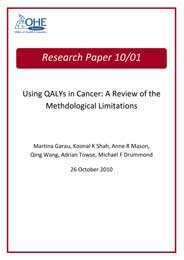Current methods for constructing quality adjusted life year (QALY) measurements may be deficient for cancer patients in three respects: descriptions of health state, valuation of health…
Current methods for constructing quality adjusted life year (QALY) measurements may be deficient for cancer patients in three respects: descriptions of health state, valuation of health state, and the source of values upon which measures are based.
Existing measures of health are either…
Current methods for constructing quality adjusted life year (QALY) measurements may be deficient for cancer patients in three respects: descriptions of health state, valuation of health state, and the source of values upon which measures are based.
Existing measures of health are either not sensitive enough or not attuned to cancer patients’ actual preferences. For example, evidence suggests that the EQ 5D instrument does not capture the small changes in health that often are very important to cancer patients.
Valuation of health states for cancer patients using traditional methods also encounters problems. For example, the time trade-off (TTO) method assumes that the rate at which people are willing to trade life expectancy for improvements in quality of life is the same under all circumstances. Research has shown otherwise, however, for the severely ill.
Whose values form the basis of health state valuations also matters. Using the general public to value health states may overvalue interventions aimed at achieving perfect health and undervalue those aimed at prolonging life or achieving small improvements in health-related quality of life.
The research proposes three possible ways forward, given these concerns.
A revised version of this paper has been published in PharmacoEconomics and can be downloaded from: http://link.springer.com/article/10.2165%2F11588250-000000000-00000
Please cite as: Garau, M., Shah, K.K., Mason, A.R., Wang, Q., Towse, A. and Drummond, M.F., 2011. Using QALYs in cancer. Pharmacoeconomics, 29(8), pp.673-685.
